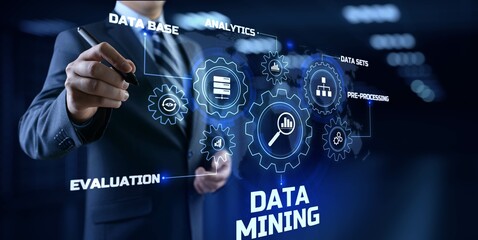
What is Data Mining? Definition and Techniques
These techniques are applied using various tools and technologies, including statistical software and machine learning frameworks. Data mining services helps businesses understand customer behavior, optimize operations, and forecast trends, making it a crucial component of data analysis and decision making processes.
Overall, data mining transforms raw data into actionable insights, driving strategic and operational improvements across diverse fields.
Discovering patterns and correlations, insights. Data Mining is the activity of gaining knowledge from large data sets which is then used to make informed decisions. It aims at analyzing huge volumes of data with the objective of extracting information that could be useful in different applications including business strategies and scientific research. The major approach in data mining is to use advanced algorithms and statistical methods: uncover hidden patterns in data it uncovers. Key techniques include:
1. Classification: Here the data is assigned to specific categories or groups based on predetermined criteria. For instance, you have emails in your inbox, and it is sorted to decide which emails belong to the spam folder.
2. Regression: It is the analysis of patterns in the dataset to anticipate future values. It is like analyzing the past sales data to draw a sales forecast graph.
3. Clustering: Groups similar items together based on their properties. Imagine grouping customers who buy similarly without knowing what “segments” are.
4. Association Rule Learning: Establishes connections among different factors within the dataset. An example would be recognizing patterns such as people who often buy both milk and bread during the same shopping trip in market basket analysis.
5. Anomaly Detection: Identifies unusual data points that deviate from the norm, useful for fraud detection.
How Data Mining Techniques is Useful in MSPs?
Data mining techniques are used primarily by Managed Service Providers (MSPs) to improve their services, make them more customer-friendly and improve on the general efficiency of their operations. Here are several ways data mining is used in MSPs:


- Predictive Maintenance: Patterns of equipment performance can be analyzed by MSPs through Data Mining and potential issues detected before they cause problems. They therefore predict when hardware may fail which makes it easier for them to schedule proactive maintenance thus minimizing downtime for their customers.
- Anomaly Detection: Through data mining, MSPs are able to detect unusual patterns or anomalies in system behavior. This may include abnormal spikes in network traffic, deviations in server performance or unusual user activities that could indicate security threats.
- Capacity Planning: By analyzing trends in resource usage using historical data, MSPs can predict future capacity needs for their clients’ IT infrastructure. They can advise on when additional resources might be needed to support business growth without affecting performance by studying resource usage trends.
- Service Improvement: A client’s use pattern and feedback data analysis allows an MSP to determine where a service can be improved. For instance, they could use data mining techniques to understand some of the common issues faced by customers and then act proactively on them.
- Customer Segmentation: Not uncommonly, an MSP serves clients of different sizes and at different levels of the service provision continuum. The analysis of data makes it possible to segment them according to criteria like, among others, usage patterns, industry type, or geographic location. This kind of differentiation provides MSPs with the opportunity of serving their clients efficiently and allows them more flexibility in the target.
- Detecting Theft: For companies that provide managed security services data mining methods can be employed as to ICT where they can detect insider theft activities. Users’ activity patterns and processed transaction information examined by MSPs which can help ward off in an early stage, any unauthorized security breaches or fraudulent transactions.
- Cost Reduction: By obtaining and planning with the help of huge amount of information, i.e., data mining, companies can look not at one but several sources of evidence effectively and by acting on various fronts, cost drivers are ameliorated and resource allocation is optimized. One such approach might be by discovering underutilized resources, plus bidding for those service contracts that seem to be inefficiently used, therefore, are available for lower prices, or proposing feasible alternatives.
- Regulatory Compliance and Corporate Reporting: Managed to Prosecution service providers are typically required of their clients to strictly adhere to all suitable international rules and guidelines for dealing with Security.
Data Mining vs. Machine Learning: Key Differences
Data Mining and Machine Learning are both techniques used for extracting insights from data, but they serve different purposes and employ different methodologies.
1. Definition and Purpose:
– Data Mining involves the process of discovering patterns, correlations, and useful information from large datasets. It is primarily focused on exploratory data analysis to uncover hidden trends and relationships. For example, data mining services can identify customer buying patterns or market trends.
– Machine Learning is a subset of artificial intelligence (AI) that uses algorithms to learn from data and make predictions or decisions. Machine learning focuses on developing predictive models and automating decision-making processes based on past data. For instance, machine learning can predict future sales based on historical data.
2. Techniques Used:
– Data Mining employs techniques like clustering, association rule mining, and anomaly detection to explore and summarize data. Techniques are often descriptive and used for data exploration.
– Machine Learning uses algorithms like decision trees, neural networks, and support vector machines to build models that can predict outcomes or classify data. Techniques are generally predictive and involve training models.
3. Process Orientation:
– Data Mining often starts with data collection and exploratory analysis to find insights.
– Machine Learning begins with a dataset to develop a model that can generalize patterns to new data.
4. Outcome and Application:
– Data Mining provides insights for understanding data and generating reports.
– Machine Learning focuses on creating systems that automatically learn and adapt to new data.
Example:
– Data Mining: It helps in analyzing transaction history to find purchasing trends.
– Machine Learning: Developing a model to forecast future sales based on the trends.
Conclusion
Data mining is the collection and grouping of data for predicting future prospects. It is used in many sectors for different purposes. In retail it helps retailers to predict the purchasing behavior of the customers to strategies for maximum sale. In medicine it is used to diagnose the disease at their early stages. Likewise it is also used in telecommunications, education, manufacturing and so forth. Moreover, some people miss-understand the data mining with Machine Learning, however, there is a slight difference between the two. If you want a premium MSP to help you with your business with data mining services for better results you can reach out to us.


